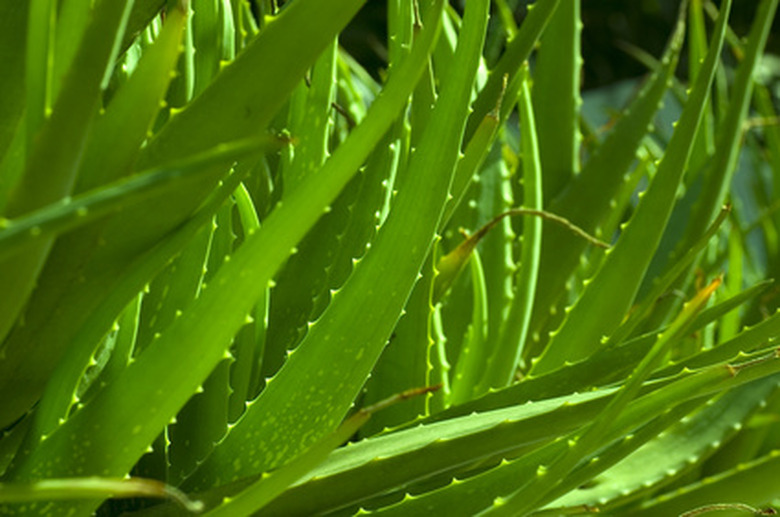The Structure Of An Aloe Vera Plant
Aloe vera, medicinal aloe, is an annual succulent native to North Africa. There are 400 species of aloe; Aloe barbadensis, also known as Aloe vulgaris or the Curacao aloe, is the most popular aloe plant and contains the most potent substances used for medicinal purposes. Aloe plants are not to be confused with agaves, succulents of the Agavacae family. Aloe plants have juicy leaves, and agave leaves, one species' leaves is the source of sap made into tequila, are fibrous.
Description
Aloe vera grows in a clump. It has fleshy, gray-green leaves arranged in a rosette in the shape of a vase atop a short stem. The leaves are about 2 inches wide and grow up to 18 inches long and have small, soft gray teeth along the edges. The main rosette of an aloe plant grows to about 2 feet high. The plant continually grows offset rosettes; in the winter and spring it yields small yellow flowers in the shape of a tube on stalks that grow up to 3 feet tall.
- Aloe vera, medicinal aloe, is an annual succulent native to North Africa.
- The main rosette of an aloe plant grows to about 2 feet high.
Life Cycle
Suckers grow from the base of the plant and may be separated from the main aloe vera to grow new plants. Aloe plants mature in four to five years; they have a life span of about 12 years.
Leaves
The green skin of the aloe leaf has a hard, waxy surface and is about 15 cell layers thick. The waxy hardness is due to the leaf's high content of magnesium and calcium. Vascular bundles just below the rind contain tubes of xylem or phloem that transport water and nutrients. The long, narrow tubes are the source of "aloe juice." A bitter, sticky yellow or orange sap will drain from the larger tubules when a leaf is cut. The center of the leaf contains a mucilage or gel.
- Suckers grow from the base of the plant and may be separated from the main aloe vera to grow new plants.
- Vascular bundles just below the rind contain tubes of xylem or phloem that transport water and nutrients.
Leaf Healing
When an aloe vera leaf is snapped or cut, the wound develops a film in a few minutes that halts the oozing of sap. The leaf continues to grow. This is the suggested origin of the folk medicine term for aloe vera as the "wand of heaven" or the "miracle plant."
Chemistry
Although an aloe plant is 99 percent or more water, it contains more than 75 other constituents including six substances that have purported medicinal properties. These include magnesium lactate that inhibits histamines that cause itching, saponins that have antiseptic properties and salicylic acid that is an anti-inflammatory. Aloe also contains 20 of the 22 essential amino acids required by the human body and 7 of 8 essential amino acids that the body must obtain from outside sources.
